View the original article to see embedded media.
Every year, the NWSL college draft gets a little more sophisticated, with more media attention, enhanced on-site staging, broader promotion and the like. While the last two drafts were held virtually due to the COVID-19 pandemic, they still marked significant steps for the league, as the 2021 event was broadcast live on Twitch and the ’22 edition aired on TV for the first time after being picked up by CBS Sports.
Those drafted in 2013, back when the league was just getting off the ground, had a very disparate experience. The event wasn’t even open to the media, and only a few players were in attendance in Indianapolis.
“They told me, ‘Download Twitter; that’ll be how you find out if you get drafted or not,’” recalls Erika Tymrak, selected 11th that year. “So I remember downloading Twitter and just kind of refreshing it. And then I found out I was drafted to Kansas City. … It’s a lot different now.”
No one quite knew the full extent at the time, but 10 years ago was a decisive and fateful time for women’s professional soccer in the United States. Its pro league, the WPS, folded that spring after just three seasons, marking the country’s second failed women’s league in a decade. Months later, a group with the subsidized backing of the soccer federations in the U.S., Canada and Mexico announced it would try again, and the NWSL was born.
Third time’s the charm … right?
When a professional sports league folds, its players are scattered to the wind. Some, like Jasmyne Spencer and Toni Pressley, join a team abroad, extending their professional careers even if it means leaving their home country. Others, like Lauren Barnes, take it as a sign to retire. Barnes had played one professional season when the WPS dissolved, trading her cleats for coaching at age 22: “I figured I gave it a go, and the talks of a women’s league lasting longer than a few years were not very optimistic,” she recalls. Still others, like Tymrak, are impacted before they even get the chance to turn pro. Tymrak was wrapping up an All-American career at Florida, feeling like she was playing too well to have things end in college.
The creation of the NWSL was a game-changer for all of them—and the couple-hundred others who made up the eight teams’ inaugural rosters in 2013. Unlike the WUSA and WPS, the NWSL reached Year 3 and then pushed past it, doubling and even tripling the lifespan of its predecessors.
This weekend, the NWSL will officially kick off a milestone 10th year as it opens regular-season play. Spencer, Pressley, Tymrak and—yes—even Barnes, will all be there, veterans on the field and pioneers of a league that has achieved something for women’s soccer once seen as a pipe dream in the country.
“Ten years seems like forever, but in the grand scheme of a professional league, it's still very young,” says Spencer.
Says Barnes: “We always say it’s been 10 years, but we’re 10 years young. A lot of other leagues like the NFL, NHL, NBA, WNBA, whatever it may be, they’re all 20-plus years old.”
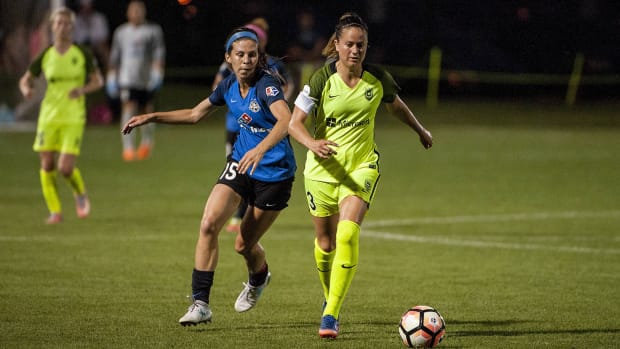
Amy Kontras/ZUMA Press/Imago Images
Of the roughly 200 players who were on an NWSL roster in its maiden season, only 28 are still active players in the league. The majority of those players have had significant national-team stints, whether with the U.S., Canada or another country—names like Alex Morgan, Megan Rapinoe, Christine Sinclair and Kelley O’Hara. Only eight of the 28 still in the NWSL have made fewer than five international appearances in their career.
Players like Spencer, Barnes, Pressley and Tymrak—who have just three USWNT caps among them, all belonging to Tymrak—are backbones of the league, having been there for its inception, going through highs and lows and serving as stabilizing forces on rosters during major events like the World Cup and the Olympics. Over the last decade, they’ve seen minimum salaries as low as $6,000 for a 22-game season. They’ve seen countless players take second jobs or live with host families just to afford a professional career. They’ve seen franchises disband, either completely or to have the entire roster transferred to a new location. They’ve seen the league expand to nine and then 10 teams, then back to nine, again to 10, and now to an all-time high of 12. They’ve navigated the COVID-19 pandemic, have seen abusive coaches ousted, watched TV ratings soar and helped ratify the first collective bargaining agreement in women’s soccer history earlier this year.
“I look back to where it was in 2013 to where it is now, and it’s night and day,” says Tymrak, now a midfielder for the Orlando Pride. “That doesn’t mean there’s still not things that we need to fight for and things that need to get better.”
When it formed, the NWSL wanted to avoid the mistakes that doomed the WUSA and WPS: financial and resource woes, declining attendance and a powerful renegade owner. That meant approaching things differently from the jump.
“The other two [leagues] kind of went so big, so fast, and weren’t sustainable, that this one was going to be a slow burn to stay,” says Spencer.
“You’d hear stories of people being really stupid and making really bad decisions,” says Jess Fishlock, a Welsh midfielder who joined OL Reign for its inaugural season in 2013 and has been there ever since, winning NWSL MVP honors in ’21. “Surely because of the history of women’s football in the leagues in the U.S., you kind of understood why the NWSL was so cautious.”
That caution included everything from low salaries ($6,000 minimum, $30K maximum in 2013; the league’s minimum salary would not go higher than $7,200 until ’17) to unceremonious playing environments.
“Looking back at some of the venues that played out in the first couple years, it was a bit shocking,” says Pressley.
“The first year in the league there were very few soccer-specific stadiums that we were playing in. I want to say maybe only Portland,” says Spencer. “And the other ones were like high school turf fields or back-of-training facility fields, and at the Boston [Breakers] field, we had rolling bleachers.”
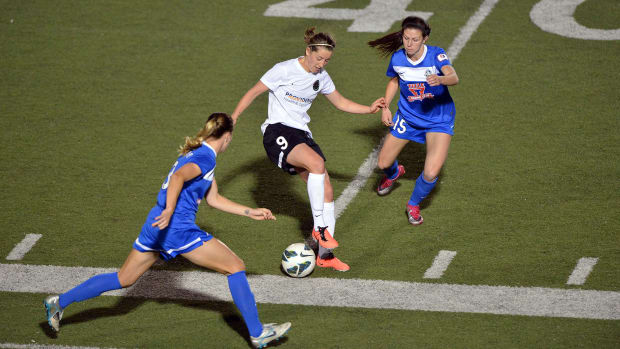
Peter G. Aiken/USA TODAY Sports
Getting traded has long been practically a rite of passage in the NWSL, and Barnes notes that until recently, the moves often came with no warning and little protection for the player(s) involved.
Barnes and Fishlock are among a handful of NWSL players who have been with the same team for all 10 seasons, joined only by teammate Rapinoe and Sinclair (Portland Thorns), Tori Huster (Washington Spirit) and Alyssa Mautz (Chicago Red Stars). “It definitely is an honor to say that,” says Barnes. “It’s a testament to what [club founders Teresa and Bill Predmore] wanted to create … an environment where players felt valued.”
At the opposite end of the spectrum is Spencer, who has played for six teams across her 10 seasons. “It takes a lot of adapting,” she says. “I always approached it with a positive attitude, and a lot of my moves happened because of expansion drafts … So I feel like [they] kind of correlated with the growth of the league, and so that therefore I had a positive experience with them.”
The 31-year-old is now a forward for Angel City FC, one of two highly anticipated California expansion clubs debuting in 2022. The franchise is “pushing the sport to a whole other level,” Spencer says, on the back of its involvement in the community and the fact that it is majority-women owned. “What they’re trying to create for the future is unprecedented.”
Spencer was selected by ACFC in a recent expansion draft, but her first experience with one came in 2016, when the Pride selected her from Western New York Flash. The move opened her eyes to the progress the NWSL had made.
“Prior to that, the league had already gone past the stigma of ‘no league has made it three years,’ but I wouldn’t say that it felt truly sustainable at that point before Orlando came in. There was no livable wage at that time, there was no mandatory housing provided, a lot of people were still living with host families—and so many people that I either played with in college or were in my draft class had moved on and entered the workforce, because they just didn’t have an option to otherwise.
“So I feel like when Orlando came into the league, they were owned by an MLS club with the idea that ‘whatever the men get, the women are gonna get, too.’ And I was actually there that first year, and it just felt different.”
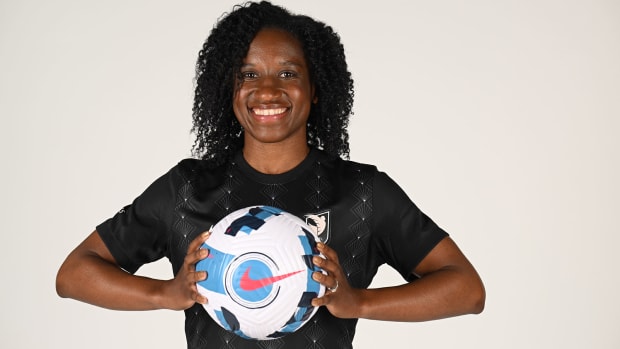
USA TODAY Sports
Multiple players cite the excitement generated by the 2015 Women’s World Cup, won by the U.S., as having been a major boon for the NWSL. “There was just a lot of positive energy around women’s soccer that hadn’t been felt since I was a little kid [when] the ’99ers were really busting on the scene,” says Spencer.
Still, things were far from perfect for the still-fledgling league. In 2017, active non-USWNT federation players formed a players’ association, which received formal union recognition in ’18. Of main priority: negotiating a collective bargaining agreement that would create much-needed baseline standards and protocols to protect players. On Feb. 1 of this year, the CBA dream became a reality, establishing a 160% increase on minimum salaries, a robust benefits and severance package, guardrails against poor playing surfaces and more—including the birth of free agency, starting in ’23.
“It was a really hard and long and trying experience fighting for the rights of so many players and future players,” says Pressley, who served as a players’ association rep for the Pride in 2020 and ’21. “But you know, it’s something that we were longing for and [was] so needed way back when the league first started, but to now have it 10 years later, we’ve come a long way.”
Barnes believes the CBA will directly tie into extending career lengths. “I think [not having one] did cut careers short in terms of financial [impact] or just being uprooted with no protection,” she says.
While the higher minimum salary—now $35,000, with a team salary cap of $1.1 million (more than five times the cap in 2013)—has grabbed headlines, veteran players say two of the more significant developments from the CBA have flown under the radar: a 401(k) program matched by the NWSL and up to six months of paid mental health leave.
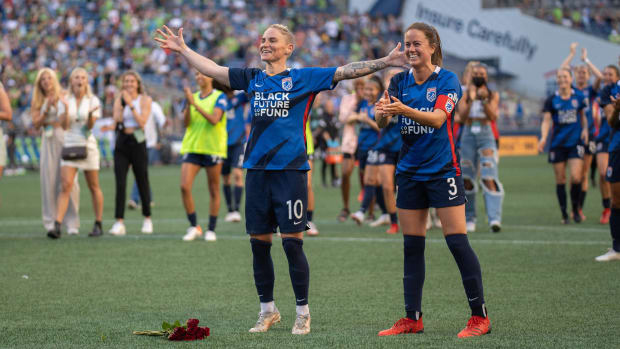
Dantey Buitureida/SPP/Imago Images
“I think [having a 401(k)] is hugely important for athletes,” says Fishlock. “Because your career is such a short one, you don’t tend to think about [an] after-retirement pension.
“I also think that six months’ paid mental health leave is huge,” she continues. “I don’t think there’s many workplaces that will give you paid leave for six months if you need it from a mental health perspective. That really sets the tone on how we view the league with regards to players’ welfare, not just physical but mental as well.”
Tymrak has personally experienced how an athlete’s mental health can derail their career, having announced her retirement in January 2020, at age 28, before rejoining the league a year later. Upon her return, she told The Equalizer she had been “extremely burnt out mentally” and knew she “needed to step away from the game.” She calls the provision in the new CBA “big for sports in general.”
“Not only is it huge for the players, but now they can actually feel like, Hey, if mental health is something I’m struggling with, I do have options. It’s not, ‘I quit or retire or I keep putting myself through this.’ There’s options. And I also think it’ll encourage people to talk about it more.”
The sea of change in the NWSL included a tumultuous 2021 that rooted out coaching abuse and toxic environments at several clubs, and resulted in the resignation of commissioner Lisa Baird. The fact that the misconduct, in many cases, dated back to earlier years of the league and was kept under wraps for so long—although it hasn’t been limited to back then, following fresh allegations against Houston coach and GM James Clarkson, who has been suspended—was another reason getting a collective bargaining agreement in place before the ’22 season was so vital.
“Players feel safe now that we have a CBA, and we actually feel like we have, not only rights, but we have a platform to speak about issues that 5–6 years ago, I don’t know if we would speak about them in fear of the league not being able to sustain that type of scrutiny,” says Tymrak. “But now that there is more stability, I think it gives players more security and more power to actually speak out about issues that affect us.”
As the league moves forward into a new era, there’s a point of emphasis amongst players on an area with room for growth.
“I think that the next big push is to fill those stadiums up,” says Tymrak, who notes her belief that clubs need to market not just to youth leagues and players, but adults as well.
“I think [teams are] now starting to understand that actually, the game-day experience is everything,” says Fishlock. “You only have to go to a game, enjoy it and then you’re kind of hooked … Over the last couple years, the game-day experience, clubs have really started to invest money in that, and I think you’re starting to see a better product because of it.”
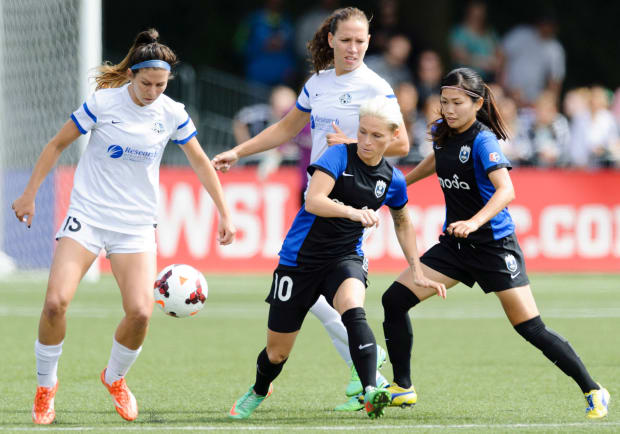
Steven Bisig/USA TODAY Sports
In addition to her time in the NWSL, Fishlock has had stints in several leagues, including England’s WSL—considered by many to be the women’s league most analogous to the U.S.’s. “One thing that America does incredibly well that I think that the WSL and Europe in general don’t do—and I think Barcelona is starting to do now, actually—is that we do create each game to be a really big event; every game is super competitive,” she says.
Still, Fishlock understands the natural obstacles that any soccer league in the U.S. faces that one in a place like England doesn’t: “The unfortunate thing is soccer is not the No. 1 sport, so we are constantly not just building women’s soccer; we’re also building soccer in general in America. … Everything [in England] is built on complete history that the NWSL just doesn't have, right?”
One way the NWSL can attempt to combat this is through embracing its own organic rivalries, given the success of the long-standing ones overseas. Barnes, Fishlock and Spencer have all experienced the Cascadia rivalry; pitted between Pacific Northwest foes Portland Thorns and OL Reign, it’s by far the biggest annual conflict in the league.
“I think the buzz it creates around these games, we always talk about it up here at the Reign,” Barnes says. “I’m sure it’s very similar down in Oregon that sometimes these games, they’re just as big as championship games. … They’re what we live for and what we play for, and why we want to be competitors in the first place.”
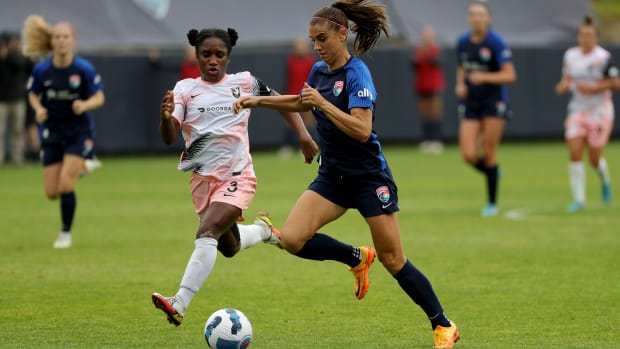
Kiyoshi Mio/USA TODAY Sports
With the debut of San Diego Wave FC and Los Angeles–based Angel City FC in 2022, it’s a golden opportunity for the league to cultivate another regional clash. “You can already see it kind of evolving with their marketing,” notes Barnes. “As those two clubs continue to grow, I think that’s going to be a really fun rivalry.”
If the NWSL can continue to grow its fan base—whether it’s through marketing, rivalries or investments in stadium atmospheres—players believe it will lead to a domino effect that will benefit not just the league and its teams, but also athletes at an individual level.
“I think at the end of the day, the elephant in the room is financial standpoint,” says Barnes. “If you want players to stay around and have the best of the best, that comes with money. With every professional sport it does. So I think it’s finding ways to provide a living for these players where you don’t have to think about holding a second job regardless if you’re a rookie or have 10 years in the league. … We talk about no side hustles, and that’s definitely a thing. And I think the more that this league can provide that for players, the more you’ll create this environment that girls want to stay and you get the best players, and I think it literally is full circle.”
As the NWSL gears up for its next 10 years, its longest-tenured players are simultaneously looking back with pride on how far the league has come—Twitter is now more a home for #NWSLAfterDark, hilarious memes and clubs boasting about their drip than it is for players learning about their professional fates—while continuing to lead the push for more.
“I’m excited to still fight that fight while I’m in season,” says Barnes. “And then whenever I do step away from the game, I think it’s still a huge part of our jobs as veterans to continue to help that.”
For Pressley, that fight includes “ensuring that all the clubs are on the same level playing field in terms of facilities, locker rooms, resources, even rights,” she says. “I think there’s so much to do, and I think there are a lot of leagues around that we can look to and get guidance from and emulate.”
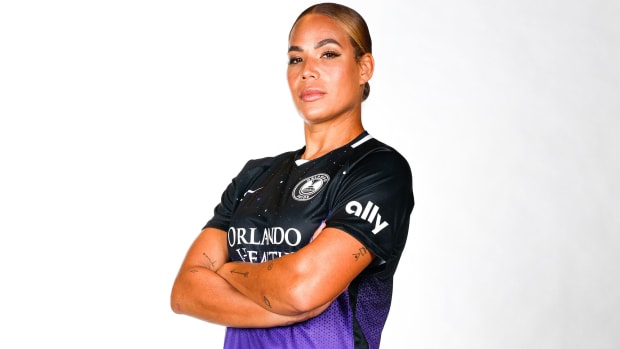
USA TODAY Sports
Spencer can already feel the momentum building for Year 10, with her Angel City team having made its debut last month in the league’s preseason Challenge Cup tournament.
“San Diego just sold out their first home opener,” she notes. “[Angel City] had 8,000-plus at our Challenge Cup home opener. … [OL Reign] are finally playing in the MLS stadium, which they long deserved; they set a new NWSL attendance record [27,248 at Lumen Field] playing there last year. It’s really exciting that you can just feel the growth and then see it and really enjoy the atmosphere when you get to play in it. It’s incredible.”
And as the veterans add another year to their career résumé, they have advice for their teammates who are just starting out on their professional journeys.
“Keep striving for standards and quality and driving the game in the U.S. forward and fighting for what you want and for what you deserve—because you absolutely deserve anything that you want in this game, and it’s attainable,” says Pressley.
“It’s a really tough league to be a part of, but that’s why we love it so much,” says Barnes. “Just enjoy the journey, because it is a crazy and wild one. But I’ve been doing it for 10 years, and I wouldn’t change a day of it.”







